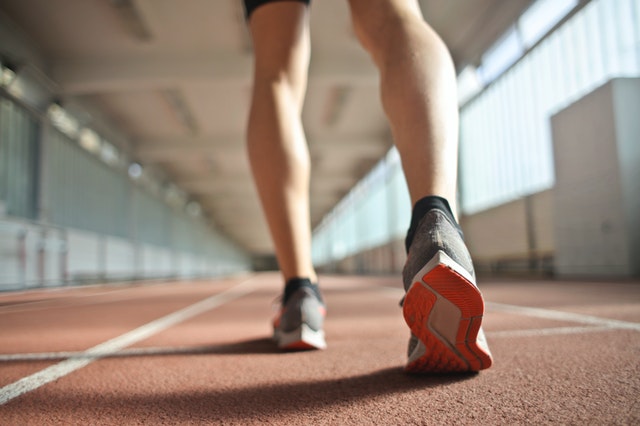Running can have multiple health benefits and is one of the most common physical activities practiced around the world.
However, running-related injuries can sometimes occur.
Unfortunately, the drawback is that multiple factors may contribute to causing a running-related injury.
Some risk factors for injury can include demographics, lower limb anatomy, training behavior, and the type of footwear chosen for the activity (1).
Additional factors that can influence an injury during running can be running experience, speed, body mass, and surface type (2).
Running-related injuries are frequent and most running injuries involve the back and the lower limbs (1).
The ‘correct’ type of running shoe is frequently decided by matching the characteristics of the shoe to one’s foot morphology.
Some of these characteristics include a heel-to-toe drop, thickness of the midsole hardness, stability factors, and age of the shoe and how often it has been used (1).
Shock absorption properties in the sole and the type of materials used for its density and structure have also been studied in relation to abstaining from a running-related injury.
The rationale for promoting cushioning material is that it can potentially minimize the impact forces on joints when running on hard surfaces (1).
What Are Flat Feet?
‘Flat’ feet, or abnormally flat arches are also known as ‘pronated’ feet and are characterized by the flatness of the arch of the foot.
Flat feet can be congenital or acquired.
They occur either due to congenital weakness of the muscles in the arches or can be acquired by stretching of the arch ligaments and weakness of the muscles in the arches.
Additional causes of flat feet can be a lack of muscle tone or weak foot muscles which cannon maintain the body’s weight (3).
Flat feet are typically painless, do not influence the ability to walk, and do not cause changes in posture.
Some adolescents and adults can be prone to a falling arch. This may be due to a temporary strain of the foot caused during an activity that assisted in overstretching of the ligaments in the arch and is typically accompanied by pain.
Rigid flat feet can be caused by changes to the shape of the foot bone, due to a short Achilles tendon or as a result of an injury.
Spastic flat feet develop because of a deformity in the heel, causing pain and clumsiness during locomotion (3).
Although flat feet have been considered a significant factor in developing an injury, many recent studies have actually proved this notion to be otherwise.
A pronated foot can be a protective factor against an injury during running, whereas factors such as training errors or dysfunctional musculature of the hip are much more likely to contribute to an injury (4).
Determining the Best Running Shoes According to Arch Type
Running shoes are typically categorized into three groups: motion-control shoes, stability shoes, and neutral or cushioned shoes.
Flat or Pronated Feet
Due to low arch, motion-control or high-stability shoes with firm midsoles are recommended, as this type of shoe offers more resistance to twisting and bending.
Cushioned shoes and shoes with a high curve are not beneficial for people with flat feet (5).
Highly cushioned shoes may reduce sensory feedback, ultimately further increasing pronation and increasing the risk of an injury.
Harder, stiffer midsoles often found in stability or motion control shoes reduce the chances of the foot rolling inward.
Therefore, anti-pronation shoes which contain stiff or dual-density midsoles or a rigid heel will prevent the foot from tipping inwards (1).
High-Arched or ‘Supinated’ Feet
High-arched feet have a very narrow band between the forefoot and the heel (5).
Because high-arched feet do not provide a good level of shock absorption, cushioned shoes deliver an additional level of support to facilitate better foot motion.
Cushioned shoes are also beneficial for rigid feet, providing additional comfort and support when playing sports (4).
‘Normal’ or ‘Neutral Feet’
Stability shoes are advised for people who have normal foot structure.
Stability shoes provide some cushioning as well as motion control (1). When choosing the ‘best’ running shoe, the most important variable is ensuring your comfort.
Although comfort is subjective and cannot be measured, evidence shows that comfort is one of the main key factors correlated with the reduction of incidences of injuries (4).
References:
1. Malisoux, L., & Theisen, D. (2020). Can the “Appropriate” Footwear Prevent Injury in Leisure-Time Running? Evidence Versus Beliefs. Journal of athletic training, 55(12), 1215–1223. https://doi.org/10.4085/1062-6050-523-19
2. Francis, P., & Schofield, G. (2020). From barefoot hunter gathering to shod pavement pounding. Where to from here? A narrative review. BMJ open sport & exercise medicine, 6(1), e000577. https://doi.org/10.1136/bmjsem-2019-000577
3. Secrest, R. (2019). Flat feet. Magill’s Medical Guide (Online Edition).
4. Griffiths, I. (2012). Choosing Running Shoes. SportEX Dynamics, 33, 28–33.
5. Kline, C. M. (2012). Ergonomic Equipment. Journal of the American Chiropractic Association, 49(5), 26.
Photo by Andrea Piacquadio from Pexels



